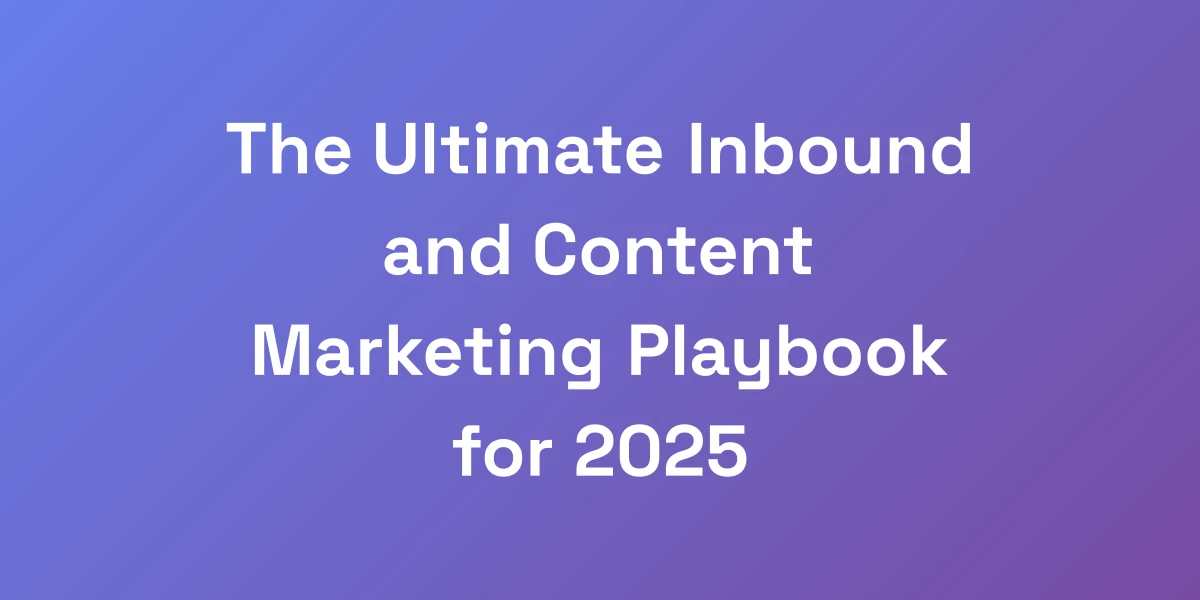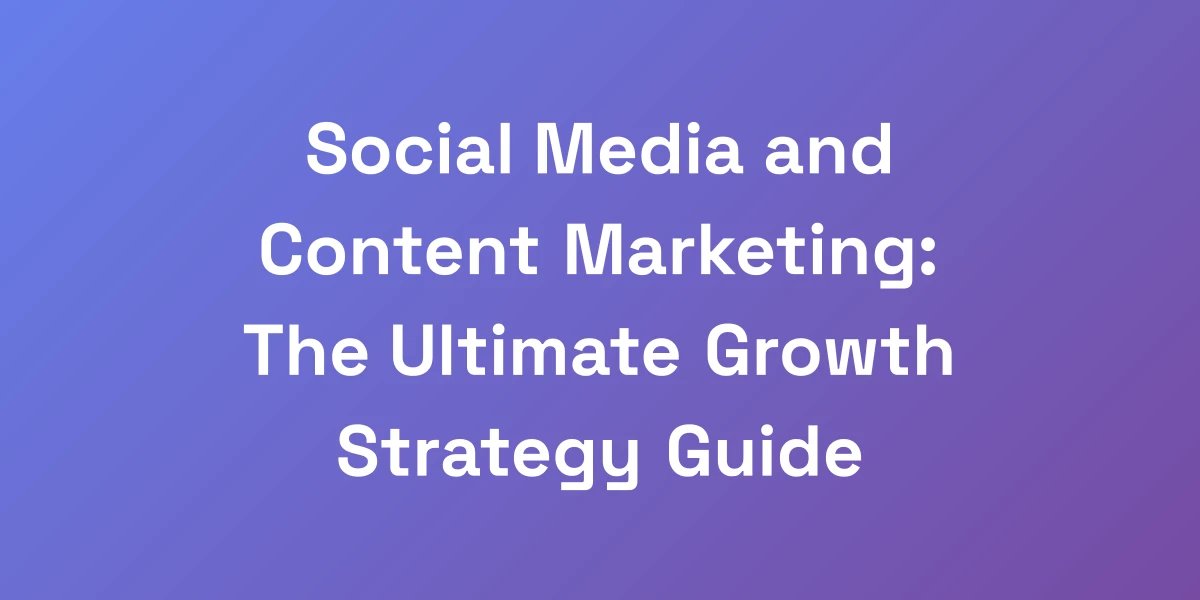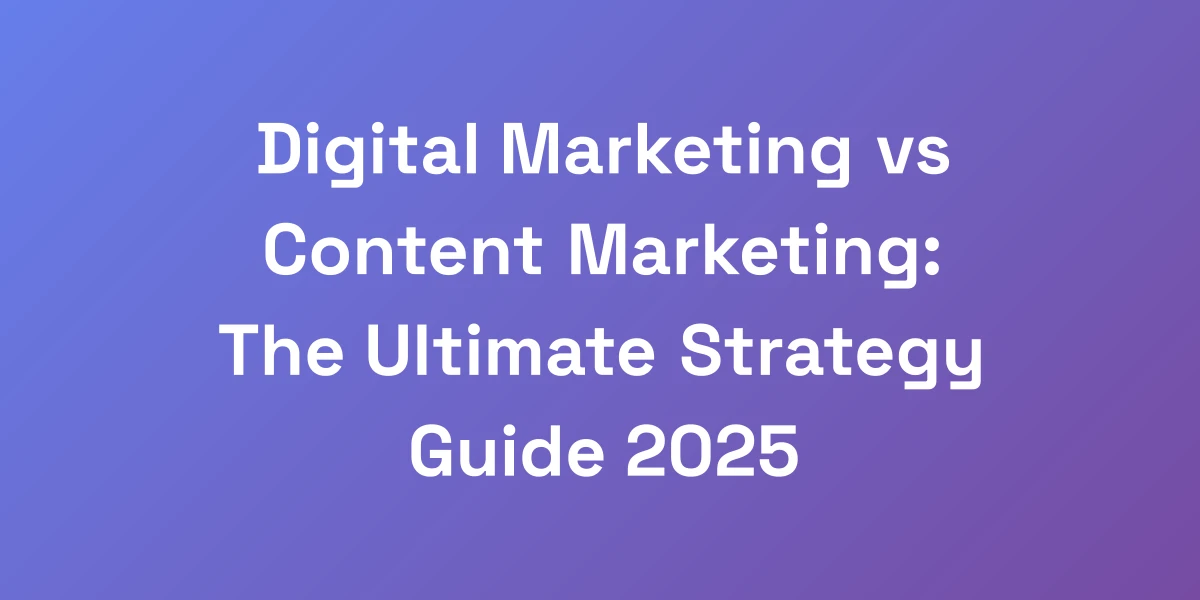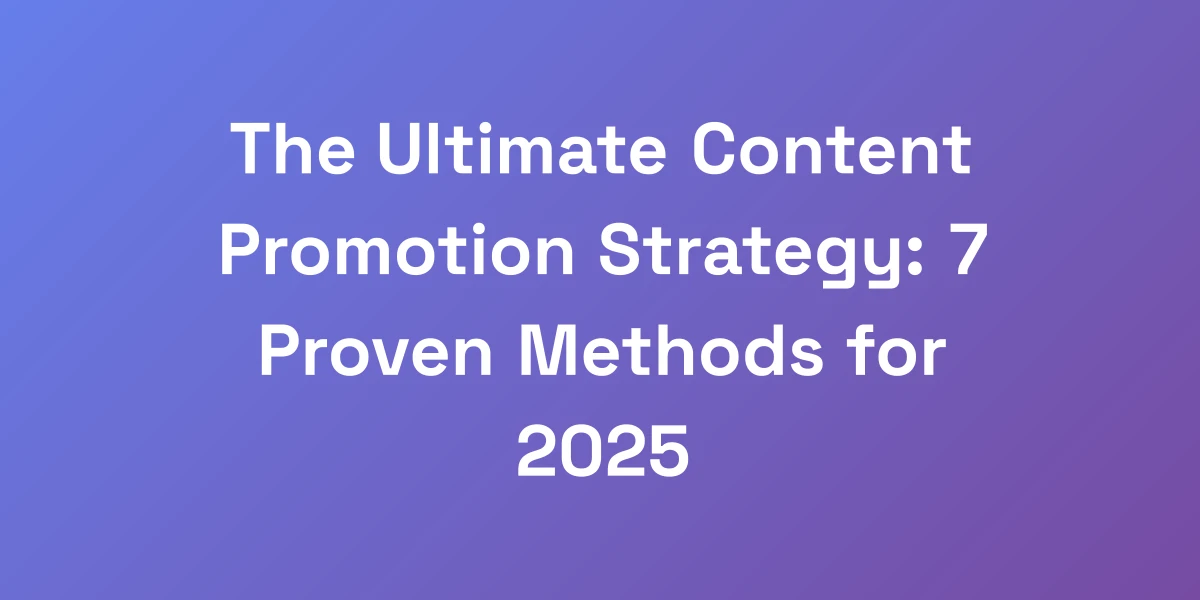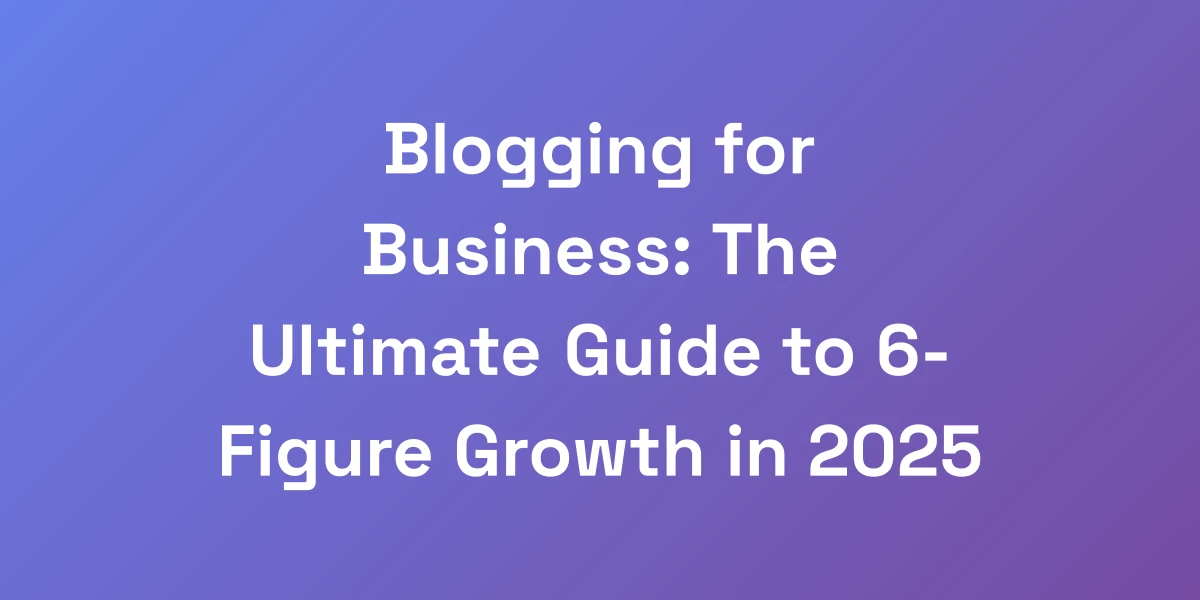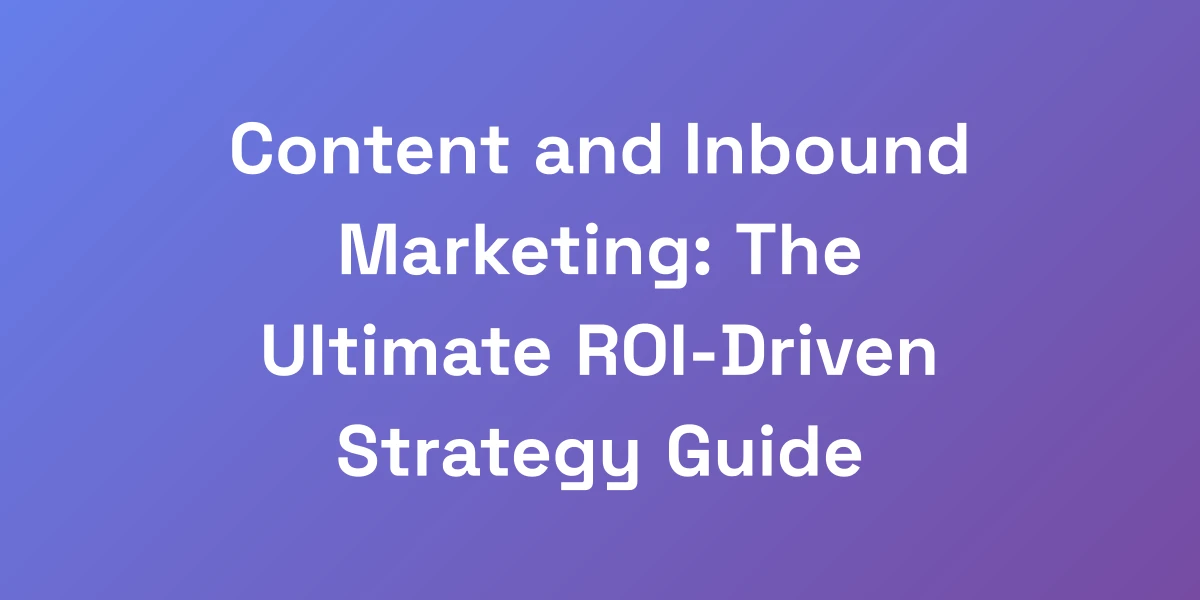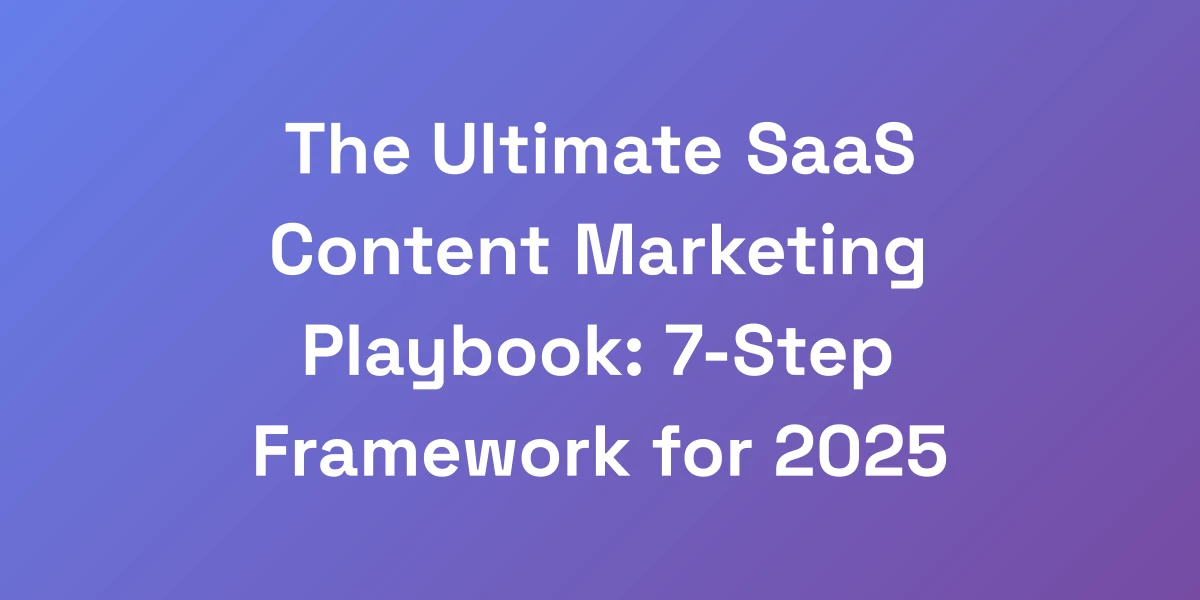
Blogging and Content Marketing: The Ultimate Growth Strategy for 2025
Mar 25, 2025 | By [email protected]
Introduction
Let’s cut to the chase: if you’re not leveraging blogging and content marketing together, you’re leaving serious money on the table.
We’ve seen it firsthand—businesses scrambling to keep up, creating content just to tick boxes, but not seeing the growth they deserve.
In the fast-evolving digital arena of 2025, the integration of blogging and content marketing isn’t just a nice-to-have; it’s the cornerstone of scaling your business to 8-figures and beyond.
Imagine transforming your content from mere text on a page to a profit-generating machine that consistently attracts, engages, and converts your ideal customers.
Sound good? Stick with us as we dive deep into the strategies that have helped companies 10x their revenue, and learn exactly how you can do the same.
The Evolving Landscape of Digital Marketing Success
Let me hit you with some truth: most businesses are doing content marketing wrong. They’re creating content just to check boxes, but here’s the reality – the game has changed dramatically.
In today’s digital arena, the integration of blogging and content marketing isn’t just a nice-to-have; it’s the difference between scaling to 8-figures or staying stuck. We’ve personally seen businesses 10x their revenue by mastering this combination, and we’re going to show you exactly how they did it and how you can too.
The Current State of Digital Marketing
The digital marketing landscape in 2025 is a battlefield where only the prepared survive.
Traditional tactics are losing their edge as consumers become more savvy and demand higher quality, more personalized content.
Businesses are shifting their focus towards creating value-driven content that not only attracts but also retains customers.
With content marketing generating over three times as many leads as outbound marketing at 62% less cost, the numbers speak for themselves.
- Content marketing leads are more cost-effective.
- High ROI with strategic content planning.
- Enhanced brand authority and trust.
Why Traditional Marketing Methods Are Dying
Traditional marketing methods, like cold calling and print ads, are rapidly losing their effectiveness.
Why? Because consumers are bombarded with these messages daily and have developed effective filters to ignore them.
Moreover, traditional methods lack the personalization and engagement that modern consumers crave.
In contrast, blogging and content marketing offer a way to connect authentically with your audience, providing value that drives trust and loyalty.
- Reduced effectiveness of interruption-based marketing.
- High cost with diminishing returns.
- Lack of personalization and engagement.
The Rise of Value-First Marketing
Value-first marketing is redefining how businesses attract and retain customers.
Instead of pushing products, it’s about providing valuable information that meets the needs and interests of your audience.
By prioritizing value, businesses can build lasting relationships, foster trust, and position themselves as industry leaders.
This approach not only enhances brand reputation but also drives higher conversion rates and customer loyalty.
- Focus on delivering actionable and relevant content.
- Builds trust and authority in your niche.
- Enhances customer engagement and retention.
Understanding the New Consumer Psychology
Today’s consumers are more informed and have higher expectations when it comes to content.
They crave authenticity, transparency, and personalized experiences.
Understanding this new psychology is crucial for crafting content that resonates and drives action.
By tapping into these psychological drivers, businesses can create more effective and impactful content strategies.
- Consumers seek authentic and transparent communication.
- Personalization is key to engagement.
- Value-driven content meets the deeper needs of the audience.
Key Statistics That Will Change Your Marketing Approach
Numbers don’t lie, and the statistics around content marketing are compelling.
Consider this: 54% of marketers will measure content marketing ROI within their company, signaling a shift towards data-driven strategies.
In the energy sector alone, content marketing campaigns have shown a landing page conversion rate of 3.1%.
And for B2B companies, those with blogs generate 67% more leads than those without.
- Content marketing leads are 62% cheaper than outbound leads.
- Marketers who prioritize blogging are 13x more likely to achieve positive ROI.
- B2B buyers heavily consume blog content during their buyer journey.
The Strategic Fusion of Blogging and Content Marketing
Listen carefully because this is where most people mess up.
They treat blogging and content marketing as separate entities when they should be viewing them as two parts of the same profit machine.
When aligned correctly, you create what we call a “value multiplication system.”
It’s not about creating more content; it’s about creating strategically aligned content that converts.
We’ve seen companies waste millions on random content when they could have 10x’d their results with half the effort using this approach.
Defining Modern Blogging Strategy
A modern blogging strategy goes beyond just writing articles. It’s about understanding your audience, delivering value, and strategically guiding them through the buyer journey.
Here’s how to define it:
- Identify your target audience and their pain points.
- Create content that addresses these pain points with actionable solutions.
- Use SEO best practices to ensure your content is discoverable.
- Integrate calls-to-action that guide readers toward conversion.
By focusing on these elements, your blog becomes a powerful tool for attracting and converting high-quality leads.
Content Marketing Framework for 2025
To thrive in 2025, you need a robust content marketing framework that’s adaptable and scalable.
Here’s a framework to follow:
- Strategic Planning: Define your goals, target audience, and key performance indicators (KPIs).
- Content Creation: Develop high-quality, value-driven content tailored to your audience’s needs.
- Distribution: Utilize multiple channels to promote your content, including social media, email, and SEO.
- Engagement: Foster interactions through comments, shares, and direct engagement with your audience.
- Measurement and Optimization: Continuously analyze performance data to refine and improve your strategy.
Implementing this framework ensures that your content marketing efforts are cohesive, targeted, and effective in driving growth.
Where Blogging Fits in Your Marketing Funnel
Understanding where blogging fits in your marketing funnel is essential for maximizing its impact.
Your blog should support every stage of the funnel:
- Top of the Funnel (Awareness): Create informative and engaging content that attracts a wide audience.
- Middle of the Funnel (Consideration): Develop content that addresses specific pain points and showcases your expertise.
- Bottom of the Funnel (Conversion): Produce persuasive content that encourages decision-making and drives conversions.
By aligning your blog content with each stage of the funnel, you ensure a seamless journey from awareness to conversion.
Creating Synergy Between Blog Content and Marketing Goals
To create synergy between blog content and your marketing goals, you need to align your content strategy with your overall business objectives.
Here’s how to do it:
- Define Clear Objectives: Whether it’s increasing brand awareness, generating leads, or boosting sales, know what you want to achieve.
- Tailor Content Accordingly: Develop content that supports these objectives at every stage of the funnel.
- Integrate with Other Marketing Channels: Ensure your blog complements other channels like social media, email marketing, and SEO.
- Consistent Messaging: Maintain a consistent brand voice and message across all content to reinforce your brand identity.
This alignment ensures that every piece of content works towards your marketing goals, enhancing overall effectiveness and ROI.
Measuring Impact and ROI
Measuring the impact and ROI of your content marketing efforts is crucial for understanding what’s working and what needs improvement.
Here are key metrics to track:
- Engagement Rate: Measures how actively your audience interacts with your content.
- Conversion Rate: Tracks the percentage of visitors who take desired actions after consuming your content.
- Time on Page: Indicates how long visitors are spending on your content, reflecting its value and relevance.
- Backlinks: Signals the authority and credibility of your content.
- Monthly Page Views Growth: Shows the increasing reach and popularity of your content.
- Monthly Website Visitors Growth: Highlights the overall increase in traffic driven by your content marketing efforts.
Regularly analyzing these metrics allows you to optimize your strategy, ensuring continuous improvement and maximum ROI.
Building Your Content Engine for Maximum Impact
Here’s the brutal truth about content creation: 90% of businesses are playing in the kiddie pool while the real money is in the deep end.
Creating a content engine isn’t about pumping out blog posts – it’s about building a Best ERP Software for Small Business and integrating systems like the SEO Freelancer’s Blueprint.
We’re going to show you how to create content that doesn’t just attract readers but converts them into SEO Freelancer’s Blueprint customers. This is the exact system we used to generate $100M+ in revenue.
Content Planning and Calendar Creation
A well-structured content plan is the backbone of a successful content engine.
Here’s how to get started:
- Set Clear Goals: Define what you want to achieve with your content—be it brand awareness, lead generation, or sales.
- Identify Key Themes: Focus on topics that resonate with your audience and align with your business objectives.
- Create an Editorial Calendar: Plan your content schedule in advance to ensure consistency and strategic distribution.
- Assign Responsibilities: Clearly define who is responsible for creating, editing, and publishing each piece of content.
By meticulously planning your content, you ensure that every piece serves a purpose and contributes to your overarching strategy.
Topic Research and Keyword Strategy
Effective topic research and a robust keyword strategy are critical for driving traffic and visibility.
Here’s how to excel in this area:
- Understand Your Audience: Use surveys, interviews, and analytics to identify what your audience is searching for.
- Competitive Analysis: Analyze what your competitors are doing and identify gaps you can fill.
- Longtail Keywords: Focus on specific, less competitive keywords that attract high-intent visitors.
- SEO Best Practices: Incorporate keywords naturally into your content, titles, and meta descriptions to enhance search engine visibility.
Implementing a strategic keyword approach ensures your content reaches the right audience at the right time.
Content Creation Frameworks That Convert
Creating content that converts requires a strategic approach. Here’s our framework:
- Identify the Purpose: Understand the goal of each piece—whether it’s to inform, engage, or convert.
- Craft Engaging Headlines: Develop compelling titles that grab attention and encourage clicks.
- Provide Value: Ensure your content offers actionable insights and solutions to your audience’s problems.
- Use Storytelling: Incorporate narratives and real-life examples to make your content relatable and memorable.
- Include Clear CTAs: Guide your readers towards the next step, whether it’s subscribing, downloading, or purchasing.
By following this framework, your content will not only attract readers but also drive them towards meaningful actions.
Distribution and Promotion Strategies
Creating great content is just half the battle. The other half is ensuring it reaches your target audience.
Here are effective distribution and promotion strategies:
- Social Media: Share your content across relevant platforms to maximize reach and engagement.
- Email Marketing: Use your email list to distribute content directly to interested subscribers.
- SEO Optimization: Optimize your content for search engines to increase organic traffic.
- Content Syndication: Partner with other websites and platforms to republish your content.
- Paid Promotion: Invest in PPC campaigns and sponsored posts to amplify your content’s visibility.
By diversifying your distribution channels, you ensure that your content reaches a broader and more engaged audience.
Analytics and Optimization Techniques
To maintain a high-performing content engine, continuous analysis and optimization are essential.
Here’s how to stay on top:
- Track Key Metrics: Monitor engagement, conversion rates, and other KPIs to assess performance.
- A/B Testing: Experiment with different headlines, formats, and CTAs to determine what works best.
- User Feedback: Gather insights from your audience to understand their preferences and pain points.
- Refine Content: Regularly update and improve your content based on performance data and feedback.
By continuously optimizing your content, you ensure it remains relevant, effective, and aligned with your business goals.
Advanced Monetization Strategies
Stop leaving money on the table with basic blogging strategies.
The real money isn’t in ads or affiliate links – it’s in using your content as a Best Lawyer SEO Companies.
We’re about to reveal the exact framework we use to turn blog readers into $25k+ clients. This isn’t theory – these are battle-tested strategies that have generated millions in revenue for our clients and ourselves.
High-Ticket Content Funnels
High-ticket content funnels are designed to nurture leads through a series of strategic content pieces that build trust and guide them toward making significant investments.
Here’s how to build one:
- Awareness Stage: Create informative blog posts that attract a broad audience.
- Consideration Stage: Develop in-depth guides and case studies that demonstrate your expertise.
- Decision Stage: Offer personalized consultations or premium services that convert leads into high-ticket clients.
- Retention Stage: Continue providing value through exclusive content and follow-ups to maintain client relationships.
This structured approach ensures that your content not only attracts leads but also effectively converts them into high-value customers.
Email List Building Through Strategic Content
An engaged email list is a goldmine for monetization.
Here’s how to strategically build and utilize your email list:
- Offer Valuable Incentives: Provide exclusive content, e-books, or discounts in exchange for email sign-ups.
- Segment Your Audience: Categorize your subscribers based on their interests and behavior to deliver personalized content.
- Automate Email Sequences: Set up automated sequences that nurture leads with relevant content and offers.
- Engage Regularly: Maintain consistent communication with your subscribers to build trust and keep your brand top-of-mind.
By effectively building and nurturing your email list, you create a direct line to your most engaged and valuable prospects.
Creating Premium Content Products
Transforming your blog content into premium products is a powerful monetization strategy.
Here’s how to do it:
- E-books and Guides: Compile your best blog posts into comprehensive e-books or guides that offer additional value.
- Online Courses: Develop in-depth courses that teach your audience specific skills or knowledge based on your expertise.
- Membership Programs: Offer exclusive access to premium content, resources, and community support.
- Webinars and Workshops: Host live sessions that provide valuable insights and direct interaction with your audience.
By creating premium content products, you not only generate additional revenue streams but also enhance your authority and value proposition.
Leveraging Content for Client Acquisition
Your content can be a powerful tool for acquiring high-ticket clients.
Here’s how to leverage it effectively:
- Showcase Expertise: Use your blog to demonstrate your knowledge and establish yourself as a thought leader in your Best Lawyer SEO Companies.
- Build Trust: Consistently providing valuable and reliable content builds trust with your audience.
- Incorporate CTAs: Strategically place calls-to-action that guide readers toward consultations, demos, or premium services.
- Case Studies and Testimonials: Highlight successful client stories and testimonials to reinforce your credibility and effectiveness.
By strategically using your content to showcase your expertise and build trust, you can effectively convert engaged readers into high-ticket clients.
Scaling Your Content Revenue
Scaling your content revenue requires a systematic approach and the right tools.
Here’s how to achieve it:
- Repurpose Content: Transform blog posts into different formats like videos, podcasts, or infographics to reach wider audiences.
- Automate Processes: Use automation tools to streamline content creation, distribution, and follow-up processes.
- Expand Your Team: Hire talented writers, designers, and marketers to increase your content output and quality.
- Optimize for SEO: Continuously improve your content’s SEO to attract more organic traffic and leads.
By implementing these strategies, you can significantly scale your content revenue while maintaining quality and consistency.
Future-Proofing Your Content Strategy
The content game is changing faster than ever, and what worked yesterday won’t work tomorrow.
But here’s the thing – while everyone else is chasing trends, we’re going to show you how to build a sustainable content system that adapts and scales.
This isn’t about quick wins; it’s about creating a long-term asset that continues to appreciate in value.
The strategies we’re about to share will work regardless of algorithm changes or platform shifts.
Emerging Content Trends and Technologies
Staying ahead of emerging trends and technologies is crucial for future-proofing your content strategy.
Here are some trends to watch:
- Interactive Content: Quizzes, polls, and interactive infographics are becoming increasingly popular for engaging audiences.
- AI-Generated Content: Leveraging AI tools to create and optimize content more efficiently.
- Video and Live Streaming: Video content continues to dominate, offering dynamic ways to connect with your audience.
- Voice Search Optimization: With the rise of smart speakers, optimizing content for voice search is becoming essential.
By embracing these trends, you can ensure your content remains relevant and engaging.
AI Integration in Content Creation
AI is revolutionizing content creation, offering new tools and capabilities that enhance efficiency and quality.
Here’s how to integrate AI effectively:
- Content Generation: Use AI tools like ChatGPT to brainstorm ideas, draft content, and optimize language.
- SEO Optimization: Leverage AI to analyze keyword trends, optimize on-page SEO, and improve content discoverability.
- Personalization: Utilize AI to create personalized content experiences based on user behavior and preferences.
- Performance Analysis: AI can help analyze content performance, providing insights for continuous improvement.
Integrating AI into your content creation process can significantly boost productivity and effectiveness.
Adapting to New Platform Requirements
As new platforms emerge and existing ones evolve, adapting your content to meet their requirements is essential.
Here’s how to stay adaptable:
- Monitor Platform Updates: Keep abreast of changes in algorithms, content formats, and user preferences on platforms you use.
- Flexible Content Formats: Create content that can easily be repurposed across different platforms and formats.
- Stay Informed: Follow industry news and participate in professional communities to stay updated on best practices.
- Experiment and Iterate: Test new content types and strategies, and be willing to adjust based on performance data.
By staying flexible and informed, you can quickly adapt to new platform dynamics and maintain your content’s effectiveness.
Building Sustainable Content Systems
A sustainable content system ensures that you can consistently produce high-quality content without burnout or resource depletion.
Here’s how to build one:
- Standardize Processes: Develop clear workflows for content creation, approval, and publication.
- Use Content Management Tools: Implement tools like Trello, Asana, or dedicated CMS platforms to streamline collaboration and organization.
- Maintain a Content Library: Create a repository of past content that can be updated, repurposed, or referenced as needed.
- Continuous Training: Invest in training for your team to keep skills sharp and knowledge up-to-date.
By systematizing your content operations, you ensure sustainability and scalability for long-term success.
Long-term Content Strategy Planning
Planning for the long-term is essential for maintaining momentum and achieving sustained growth.
Here’s how to approach it:
- Set Long-term Goals: Define where you want your content strategy to be in 1, 3, and 5 years.
- Regularly Review and Adjust: Periodically assess your strategy’s effectiveness and make necessary adjustments based on performance data and market changes.
- Invest in Evergreen Content: Create content that remains relevant and continues to attract traffic over time.
- Build Strong Relationships: Foster connections with influencers, partners, and your audience to support sustained growth.
A long-term perspective ensures that your content strategy remains focused, effective, and aligned with your evolving business objectives.
Conclusion
We’ve journeyed through the intricate landscape of blogging and content marketing, uncovering strategies that not only attract and engage but also convert at high levels.
The fusion of these two powerful tools is your gateway to scaling your business to unprecedented heights in 2025 and beyond.
Remember, it’s not about churning out content; it’s about delivering value strategically aligned with your marketing goals.
If you’re ready to transform your content into a revenue-generating machine, it’s time to implement these strategies and watch your business soar.
Take action today—revamp your content strategy, integrate blogging with your marketing efforts, and unlock the growth potential that awaits.
Have questions or want to share your success stories? Drop a comment below and let’s continue this conversation.

